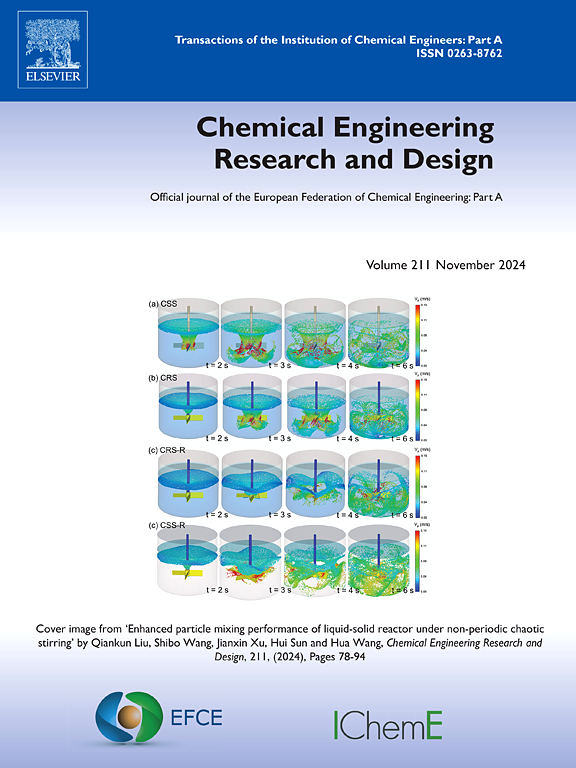利用计算流体动力学对双流体雾化器的流动行为进行计算成本效益分析
IF 3.7
3区 工程技术
Q2 ENGINEERING, CHEMICAL
引用次数: 0
摘要
在工业生产中,湿式静电除尘器(WESPs)采用单流体和双流体雾化器(TFAs)等雾化器来减少颗粒物质。与单流体雾化器相比,双流体雾化器具有多种优势,但量化其喷雾特性却更为复杂,因此有必要进行综合案例研究,以设计喷雾的内部结构并实现所需的特性。本研究采用计算流体动力学(CFD)模拟工业规模 WESP 中 TFA 的内部和外部流动现象,旨在通过降低与分析喷雾系统内高速内部流动和颗粒动力学相关的高计算成本,促进各种参数研究。为了降低计算成本,模拟分为两部分,采用逐步分离的方案:第一部分侧重于高成本的内部流动分析,研究内部流动的时空演变,直至其完全发展,然后对喷嘴处的液滴大小分布进行估算。第二部分计算了喷雾的外部流动,通过研究分散液滴之间的相互作用评估了降低成本的潜力,并根据实验数据验证了喷雾角度、穿透力和覆盖率。分离策略采用了映射技术,将两个部分完美地结合在一起。模拟结果在最小误差范围内(5%)与实验基准的喷雾角度、穿透力和覆盖率密切吻合,证明了模型在捕捉全氟辛烷磺酸实际喷雾现象方面的准确性。与传统的一步求解器相比,这种方法大大降低了二十倍以上的计算成本,为在喷雾 CFD 模拟中进行各种案例研究提供了一种可行的方法。本文章由计算机程序翻译,如有差异,请以英文原文为准。
Computationally cost-efficient analysis of the flow behavior of twin-fluid atomizers using computational fluid dynamics
In industrial-scale operations, wet electrostatic precipitators (WESPs) are used to minimize particulate matter, employing atomizers such as single-fluid and twin-fluid atomizers (TFAs). While TFAs provide several benefits over single-fluid atomizers, quantifying their spray characteristics is more complex, necessitating comprehensive case studies to design the internal structure of the spray and achieve desired properties. This study employed computational fluid dynamics (CFD) to simulate the internal and external flow phenomena of TFAs in industrial-scale WESPs, aiming to facilitate various parametric studies by reducing the high computational costs associated with analyzing high-speed internal flows and particle dynamics within the spray system. To decrease computational costs, the simulation was divided into two parts using stepwise segregated scenarios: Part I focused on the high-cost internal flow analysis, examining the spatiotemporal evolution of internal flow until it is fully developed, followed by droplet size distribution estimation at the nozzle. Part II computed the external flow of the spray, assessed potential cost reductions by examining the interactions between dispersed droplets, and validated the spray angle, penetration, and coverage against experimental data. The segregated strategy employed mapping techniques to integrate the two parts seamlessly. The simulation results closely matched the experimental benchmarks for spray angle, penetration, and coverage within a minimal error margin (< 5 %), demonstrating the model’s accuracy in capturing actual spray phenomena in TFAs. This approach significantly reduced the computational cost by more than twentyfold compared to conventional one-step solvers, offering a viable method for conducting various case studies in spray CFD simulations.
求助全文
通过发布文献求助,成功后即可免费获取论文全文。
去求助
来源期刊

Chemical Engineering Research & Design
工程技术-工程:化工
CiteScore
6.10
自引率
7.70%
发文量
623
审稿时长
42 days
期刊介绍:
ChERD aims to be the principal international journal for publication of high quality, original papers in chemical engineering.
Papers showing how research results can be used in chemical engineering design, and accounts of experimental or theoretical research work bringing new perspectives to established principles, highlighting unsolved problems or indicating directions for future research, are particularly welcome. Contributions that deal with new developments in plant or processes and that can be given quantitative expression are encouraged. The journal is especially interested in papers that extend the boundaries of traditional chemical engineering.
 求助内容:
求助内容: 应助结果提醒方式:
应助结果提醒方式:


